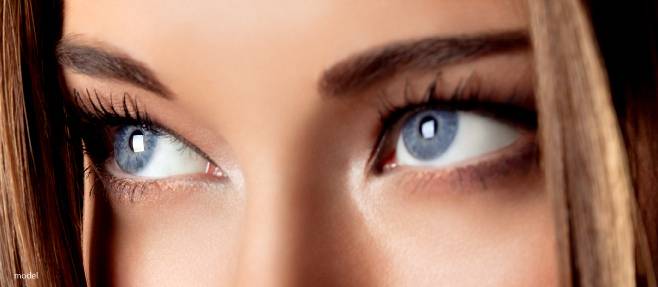The Difference Between Upper and Lower Blepharoplasty

Blepharoplasty, also known as eyelid surgery or an eye lift, is a plastic surgery procedure that can correct the upper or lower eyelid, or both, for a dramatically more youthful and vibrant appearance.
Since the skin around the eyes is thin and delicate, the area is often one of the first facial areas to reveal the symptoms of aging. Additionally, muscles that support both the upper and lower eyelids can weaken and become lax with age. This can cause drooping, puffiness, dark circles and swelling. In the most severe cases, these issues can actually obstruct one’s eye sight.
A blepharoplasty procedure can be performed to counteract these issues. The procedure is among the most commonly performed cosmetic procedures in the United States and can be done in under a few hours with local or general anesthesia.
The main difference between upper blepharoplasty and lower blepharoplasty is the eye area each affects. Upper blepharoplasty targets the upper eyelid while lower blepharoplasty addresses the lower eye. This post will explain both upper and lower blepharoplasty, as well as explain why the best choice for some patients may be a combination of both procedures.
Upper Blepharoplasty
Natural aging often results in sagging skin, excess fat tissue, and loose muscles in the upper eyelids. This can make the upper lids feel heavy and cause the upper lid to droop, sometimes significantly enough to obstruct vision. Upper blepharoplasty can resect redundant skin and tissue in the upper eye, to open up the eye and create a more youthful appearance. It can also tighten weak ligaments if the eyelid margin is drooping.
What Is Upper Blepharoplasty?
Patients with sagging skin, loose muscle, or excess fat tissue along their upper eyelids will benefit from an upper blepharoplasty procedure. This form of eyelid surgery targets the upper lids and is ideal to correct fatty or excess skin that can fall over the eye which aesthetically causes a disruption in the natural contour of the upper eyelid and in severe cases visual impairment. In some cases, the eyelid margin actually droops, obstructing vision even further. This condition, called ptosis, can also be repaired during upper blepharoplasty.
Sagging of upper eyelid skin can appear worse when the eyebrow becomes droopy with age. In these cases, a brow lift may be combined with upper blepharoplasty for even more improvement.
How Is Upper Blepharoplasty Performed?
An upper eye lift is performed by removing excess skin and muscle, and sometimes fat, through a small incision in the upper eyelid. Muscles above the eye may be repositioned before the skin is lifted and reattached.
Incisions are hidden in the crease above the eye so any resulting scarring is unnoticeable once the healing process is complete. The entire procedure normally takes between 45-60 minutes and can often be performed under local anesthesia.
How Much Is Upper Blepharoplasty?
While each case varies, the average cost of upper blepharoplasty ranges from $3,000 to $5,000. If your upper eyelid is obscuring your vision, some medical insurance plans may consider the procedure medically necessary and cover some or all of the costs.
Lower Blepharoplasty
As the lower eyelid droops with age, it may form pockets which hold shadows, causing the appearance of dark circles under the eyes. Fat or fluid can drop into the lower eyelid, causing a puffy appearance. Lower eyelid surgery (sometimes called “eye bag surgery”) can be performed to correct lines, wrinkles, sagging, or baggy skin in the undereye area.
What Is Lower Blepharoplasty?
Individuals with drooping skin or excess tissue along their lower eyelids can benefit from a lower blepharoplasty procedure. Lower blepharoplasty can address a variety of lower lid issues including eye bags (extra fatty deposits), puffiness, dark under-eye circles, wrinkling, and extreme droopiness that reveals an increased amount of the whites of the eyes.
How Is Lower Blepharoplasty Performed?
Lower eyelid surgery is performed differently depending upon your eye anatomy and the results you hope to achieve. The two common approaches either make an external incision (skin-muscle approach) or make an incision on the inside of the eyelid (transconjunctival approach).
In the external approach, an incision is made just below your lower eyelashes. Excess fat and skin are removed. Hollow areas underneath the eye may be plumped by repositioning the fatty excess from the eyelid or by lifting the cheek to fill the hollows. The lower eyelid may also be tightened if needed to improve weakness.
In the transconjunctival approach, the incision is made just inside the eyelid. The excess fat can be removed or repositioned more directly and hollows are corrected as in the external approach. The approach is favored in a younger patient or those without eyelid weakness since the support structures of the eyelid are retained better with this technique.
These procedures are slightly more involved than an upper eye lift and take between 60-90 minutes.
How Much Does Lower Blepharoplasty Cost?
Similar to upper blepharoplasty, the cost of lower blepharoplasty differs from case to case and falls in the $3,000 to $6000 range. Since issues in the lower eye rarely affect one’s vision, lower blepharoplasty is typically considered to be cosmetic and not covered by medical insurance.
Ancillary Procedures
Although blepharoplasty does a good job of improving the structure of the eyelid, it cannot tighten all the eyelid skin in many patients. For fine lines around the eyes, lasers or chemical peels are often used at the same time as blepharoplasty to help tighten saggy and wrinkled skin.
Quad Blepharoplasty: Combination of Upper and Lower Blepharoplasty
Every face is different and we all age differently in the eye area. Some patients will achieve the youthful results they desire by just undergoing an upper or lower blepharoplasty. However, in some cases the patient will benefit from undergoing a quad blepharoplasty (the combination of upper and lower blepharoplasty). A quad bleph corrects the upper and lower eye in the same procedure, providing the most dramatic result.
About Blepharoplasty Recovery
While a quad blepharoplasty procedure takes longer, approximately 2.5 hours, the recovery time is the same whether you do upper, lower, or both. After surgery, you may experience swelling and bruising. Both will subside within 7-14 days. Your doctor will send you home with pain medications and instructors to care for your incisions. Expect some discomfort such as blurred vision or dry eyes as you heal from the procedure. Most patients return to their normal daily activity within 2 weeks. Full results, including a complete reduction in swelling and minimization of scarring can take several months.
To learn more about blepharoplasty recovery, please read this post.
Disclaimer: The contents of the Westlake Dermatology website, including text, graphics, and images, are for informational purposes only and are not intended to substitute for direct medical advice from your physician or other qualified professional.
